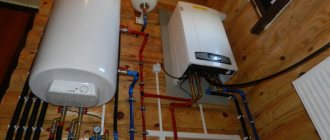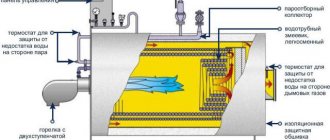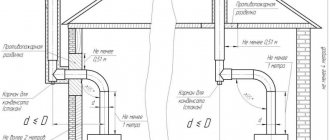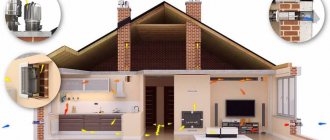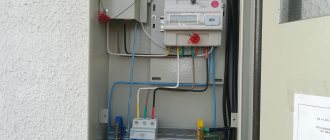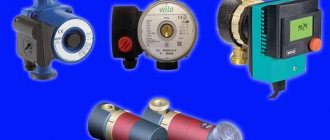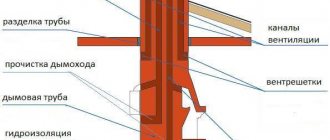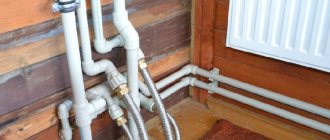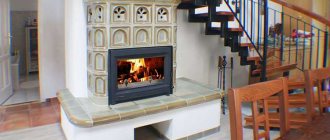Properly organizing home heating is not an easy task. It is clear that specialists - designers and installers - can handle it best. It is possible and necessary to involve them in the process, but in what capacity is up to you, the owner of the house, to determine. There are three options: hired people perform the entire range of activities or part of these works, or act as consultants, and you do the heating yourself.
Regardless of which heating option is chosen, you need to have a good understanding of all stages of the process. This material is a step-by-step guide to action. Its goal is to help you solve the heating installation problem yourself or competently supervise hired specialists and installers.
Heating system elements
In the vast majority of cases, private residential buildings are heated with water heating systems. This is a traditional approach to solving the issue, which has an undeniable advantage - universality. That is, heat is delivered to all rooms using a coolant, and it can be heated using various energy carriers. We will consider their list further when choosing a boiler.
Water systems also make it possible to organize combined heating using two or even three types of energy carriers.
Any heating system, where the coolant serves as the transfer link, is divided into the following components:
- heat source;
- pipeline network with all additional equipment and fittings;
- heating devices (radiators or heating circuits for underfloor heating).
For the purpose of processing and regulating the coolant, as well as performing maintenance work in heating systems, additional equipment and shut-off and control valves are used. The equipment includes the following items:
- expansion tank;
- circulation pump;
- hydraulic separator (hydraulic arrow);
- buffer capacity;
- distribution manifold;
- indirect heating boiler;
- devices and automation equipment.
Note. A mandatory attribute of a water heating system is an expansion tank; other equipment is installed as needed.
It is well known that when heated, water expands, and in a confined space there is nowhere for its additional volume to go. To avoid rupture of connections due to increased pressure in the network, an open or membrane type expansion tank is installed. She takes in excess water.
Forced circulation of the coolant is provided by a pump, and if there are several circuits separated by a hydraulic arrow or a buffer tank, 2 or more pumping units are used. As for the buffer tank, it works simultaneously as a hydraulic separator and a heat accumulator. Separating the boiler circulation circuit from all others is practiced in complex systems of cottages with several floors.
Collectors for coolant distribution are installed in heating systems with heated floors or in cases where a radial battery connection scheme is used, we will discuss this in the following sections. An indirect heating boiler is a tank with a coil where water for domestic hot water needs is heated from the coolant. To visually monitor the temperature and pressure of water in the system, thermometers and pressure gauges are installed. Automation tools (sensors, thermostats, controllers, servos) not only control the parameters of the coolant, but also regulate them automatically.
The basis of everything is a plan
Without knowing it, we completed the first point of the work plan - we calculated the required thermal power for heating. The general plan also includes determining the location and number of radiators, selecting pipes and necessary accessories (fittings, taps, manifold distributors, filters and other necessary parts of the heating system). The plan, usually drawn in enlarged form, marks the location of all the elements that a homemade heating system provides, and in addition, it allows you to select heating devices.
As a rule, any radiators will work in a heating system; the only question is how much they cost and what they look like. They are usually located under window openings to provide a thermal curtain. When choosing radiators, you can be guided by a rough estimate - if the coolant temperature is seventy degrees, then one section is used to heat an area of three square meters. m.
After the power of the boiler and radiators has been selected, it is time to choose pipes. The most popular and affordable are polypropylene and metal-plastic. Of course, if you decide to do the heating yourself no matter what, you can use other types of pipes, but the rest of their types are either outdated, require welding and additional operating costs (steel), or very expensive (copper).
Calculation of the heating system and selection of boiler power
It is impossible to select equipment without knowing the amount of thermal energy required to heat the building. It can be determined in two ways: simple approximate and calculated. All sellers of heating equipment like to use the first method, since it is quite simple and gives a more or less correct result. This is a calculation of thermal power based on the area of heated premises.
They take a separate room, measure its area and multiply the resulting value by 100 W. The energy required for the entire country house is determined by summing up the indicators for all rooms. We suggest a more accurate method:
- by 100 W, multiply the area of those premises where only 1 wall, on which there is 1 window, is in contact with the street;
- if the room is a corner one with one window, then its area must be multiplied by 120 W;
- when a room has 2 external walls with 2 or more windows, its area is multiplied by 130 W.
If we consider power as an approximate method, then residents of the northern regions of the Russian Federation may not receive enough heat, and residents of the south of Ukraine may overpay for equipment that is too powerful. Using the second, calculation method, heating design is carried out by specialists. It is more accurate, as it gives a clear understanding of how much heat is lost through the building structures of any building.
Before you begin the calculations, you need to measure the house, finding out the area of the walls, windows and doors. Then you need to determine the thickness of the layer of each building material from which the walls, floors and roofs are built. For all materials in the reference literature or on the Internet, you should find the value of thermal conductivity λ, expressed in units of W/(m ºС). We substitute it into the formula for calculating the thermal resistance R (m2 ºС / W):
R = δ / λ, here δ is the thickness of the wall material in meters.
Note. When a wall or roof is made of different materials, it is necessary to calculate the R value for each layer and then sum the results.
Now you can find out the amount of heat lost through the external building structure using the formula:
- QTP = 1/R x (tв – tн) x S, where:
- QТП – lost amount of heat, W;
- S is the previously measured area of the building structure, m2;
- tв – here you need to substitute the value of the desired internal temperature, ºС;
- tн – street temperature in the coldest period, ºС.
Important! The calculation should be made for each room separately, alternately substituting into the formula the values of thermal resistance and area for the external wall, window, door, floors and roof. Then all these results must be summed up, this will be the heat loss of the given room. The area of internal partitions does not need to be taken into account!
Experimental heating method with high efficiency
Smart Heart specialists have developed autonomous heating modules and devices of different types and different power levels that can be used to heat both industrial premises and private houses, greenhouses, swimming pools, and paths. You purchase the device itself, install it yourself or with the help of specialists, and connect it to the Internet.
In the future, you use it like a regular electric heater or boiler, paying your own bills for electricity consumption, and the company compensates you daily via e-wallet for the use of the computing power of your device.
Currently produced heating modules of this type can be divided into two types:
- Air heating - in them, processors are cooled using air supply. They work on the principle of conventional electric fan heaters, only instead of a spiral, the heating elements in them are working chips (processors). Such devices can be used for air heating or drying areas of the house and for creating separate comfortable zones in the room.
- Water heating - in them the heat of the chips is transferred to water. They work like electric boilers - water heated in them to a temperature of 42-45ºС is forced into the heating or hot water supply system of the house. To do this, they can be easily installed into an existing water heating system or installed specifically for this heating module. Such devices are the best option for a thermal energy generator for water-heated floors in a house, underground heating of greenhouses, paths, swimming pools or other places where heating with a low-temperature coolant is required.
Currently, Smart Heart produces the following heating modules: Air heating units:
- A1 (“Veterok”) with a thermal power of 450 W, can be used to heat small rooms at home or create a comfortable zone, compensation for computing power for this module (as of 2015) is 40 rubles per day;
- 4A1 - thermal power 1.85 kW, can be used for round-the-clock air heating or drying of house premises, compensation payments - 200 rubles per day.
Hot water installations:
- W1 - thermal power 950 W, with a nominal water temperature at the outlet of the module - 45ºС, is a good solution as a water heater for a home hot water supply system. Compensation for computing power for this block is 100 rubles/day;
- W3 - power up to 1500 W (adjustable in the range of 1-1.5 kW), with water heating temperature up to 75°C. It may be the best option for heating water in the hot water supply system of a private home. Compensation payments (in 2015) - 200 rubles/day;
- C3SS5 - with a rated power of 3 kW (adjustable within 2.5 - 4.2 kW) and an output temperature of 42ºС, is the optimal solution as a low-temperature heat generator for installing water heated floors in the house.
Of course, to heat a large house, one such device will clearly not be enough, but in this case, you can use several of these heating modules (for example, separately for each floor) or use one, but in parallel with other heat generators (gas, solid fuel, heat pump) .
Heat consumption for ventilation
To find out how much heat a private house loses as a whole, you need to add up the losses of all its rooms. But that’s not all, because we must also take into account the heating of the ventilation air, which is also provided by the heating system. In order not to go into the jungle of complex calculations, it is proposed to find out this heat consumption using a simple formula:
Qair = cm (tв – tн), where:
- Qair – required amount of heat for ventilation, W;
- m – amount of air by mass, defined as the internal volume of the building multiplied by the density of the air mixture, kg;
- (tв – tн) – as in the previous formula;
- с – heat capacity of air masses, is taken equal to 0.28 W / (kg ºС).
To determine the heat demand for the entire building, it remains to add the value of QTP for the house as a whole with the value of Qair. The boiler power is taken with a reserve for the optimal operating mode, that is, with a coefficient of 1.3. Here you need to take into account an important point: if you plan to use a heat generator not only for heating, but also for heating water for domestic hot water supply, then the power reserve must be increased. The boiler must operate effectively in 2 directions at once, and therefore the safety factor must be taken at least 1.5.
How to heat your house without going broke?
And really: how to do this? After all, heating tariffs, especially gas, remain the highest on the market to this day
If you pay attention to other methods and systems for heating a house, then if the calculations are incorrect, you can pay even more. Each of them has its own purpose and is used to achieve certain temperatures.
There will not always be 100% heat from gas heating in a private house; at the same time, the walls may not warm up completely if only convectors are used. Therefore, let's look at the different options so that by the end of the article we can decide how to heat the house in the best way.
Goal: to constantly maintain the temperature of a country house.
Regularly maintaining the temperature of the house during periods when there is no one in it at all is not an easy task. But solvable. Here are the consequences for a house without heating in winter:
- The water supply system is deteriorating.
- The pipes lose their usefulness the following year and it is necessary to invest in checking them.
- Condensation appears on the walls, which leads to mold and mildew.
And to achieve this goal, special automatically programmed thermostats were created. To heat your house in winter, you only need a standard outlet, because the device is plugged into it. Next, the devices will be turned on according to a schedule set by the owner of the house. In addition, if one of your relatives plans to spend the weekend in a country house, then indicate in advance the date and temperature that should be before their arrival. Another option for heating a house in such conditions is through remote control in applications installed on mobile devices.
Goal: quickly warm up the country house during your arrival.
To ensure that the house is warm upon arrival, in addition to automatic heating systems used while the owners are not at home, you can use other heating methods. Of course, you most likely won’t be able to turn them on remotely, but they will quickly reach the required temperature.
To do this, combine: convectors and stoves, fan heaters and oil heaters. You cannot focus on a specific type of heater. If you want to heat your home economically without harming your health, then you need to forget about using only one fan heater, which heats the air by drying the moisture. Dryness develops and you quickly want to open the window.
Recommendations for choosing a boiler
At the moment, there are various types of heating, characterized by the energy carrier or type of fuel used. Which one to choose is up to you, and we will present all types of boilers with a brief description of their pros and cons. To heat residential buildings, you can purchase the following types of household heat generators:
- solid fuel;
- gas;
- electrical;
- on liquid fuel.
The following video will help you choose an energy carrier, and then a heat source:
Solid fuel boilers
Solid fuel boilers are divided into 3 types: direct combustion, pyrolysis and pellet. The units are popular due to their low operating costs, because compared to other energy sources, firewood and coal are inexpensive. The exception is natural gas in the Russian Federation, but connecting to it is often more expensive than all the heating equipment including installation. Therefore, wood and coal boilers, which have an acceptable cost, are being purchased by people more and more often.
On the other hand, operating a solid fuel heat source is very similar to simple stove heating. You need to spend time and effort to prepare, carry firewood and load it into the firebox. The unit also requires serious piping to ensure its long-lasting and safe operation. After all, a conventional solid fuel boiler is characterized by inertia, that is, after closing the air damper, the heating of water does not stop immediately. And efficient use of generated energy is possible only if there is a heat accumulator.
Important. Boilers that burn solid fuels generally cannot boast of high efficiency. Traditional direct combustion units have an efficiency of about 75%, pyrolysis units - 80%, and pellet units - no more than 83%.
The best choice in terms of comfort is a pellet heat generator, characterized by a high level of automation and virtually no inertia. It does not require a heat accumulator and frequent trips to the boiler room. But the price of equipment and pellets often makes it inaccessible to a wide range of users.
Which heating is more profitable in the Russian Federation
Before determining the cheapest heating method, we list all the energy resources available to residents of the Russian Federation:
- various types of solid fuel - firewood, briquettes (eurowood), pellets and coal;
- diesel fuel (diesel fuel);
- waste oils;
- main gas;
- liquefied gas;
- electricity.
To figure out which heating is the cheapest, you need to find out how much heat each energy carrier can produce and how much it will cost, and then compare the data obtained. The table containing the calculation results will help you determine the most economical heating:
Anyone can perform a similar calculation by substituting the heat load on the heating system of their building and the cost of fuel in the region of residence into the table. The calculation algorithm is as follows:
- Column No. 3 contains the values of the theoretical heat transfer per unit of fuel, and column No. 4 - the efficiency (efficiency) of heating equipment using this energy carrier. These are reference values that remain unchanged.
- The next step is to calculate how much heat actually enters the house from a unit of fuel. The calorific value is multiplied by the boiler efficiency divided by 100. The results are entered in the 5th column.
- Knowing the price of a unit of fuel (column No. 6), it is not difficult to calculate the cost of 1 kW/h of thermal energy obtained from this type of fuel. The unit price is divided by the actual heat transfer, the results are in column No. 7.
- Column No. 8 indicates the average heat consumption per month for a country house with an area of 100 m², located in central Russia. For the calculation you should enter your heat consumption value.
- Average monthly costs for heating a home are indicated in column No. 9. The figure is obtained by multiplying monthly heat consumption by the cost of 1 kW obtained from various types of fuel.
The table shows 2 types of firewood usually available for sale - freshly cut and dry. This will help you understand how profitable it is to heat a stove or boiler with dry wood.
Analysis of calculation results
The calculations show that the most economical heating for private homes in the Russian Federation in 2022 is still provided by natural gas; this energy source remains uncompetitive. Please also take into account the fact that gas-powered equipment is relatively inexpensive, and is quite effective and comfortable to use.
The problem with gas in the Russian Federation is the high cost of connecting to existing pipelines. To heat your home economically, you will have to shell out 50 thousand rubles. (in remote regions) up to 1 million rubles. (In the Moscow region) for connecting to a gas pipe.
Having found out how much connection costs, many homeowners are wondering how and with what to heat their home without gas. The remaining energy sources are listed in the table:
The use of purely electric equipment for heating a house around the clock cannot be called profitable, since the cheap night tariff is valid for 8 hours a day, and the rest of the time you will have to pay the full rate. So heating with electricity alone will not work cheaply.
Gas boilers
An excellent option is to install heating that operates on main gas. In general, hot water gas boilers are very reliable and efficient. The efficiency of the simplest energy-independent unit is at least 87%, and the efficiency of an expensive condensing unit is up to 97%. The heaters are compact, well automated and safe to operate. Maintenance is required no more than once a year, and trips to the boiler room are needed only to monitor or change settings. A budget unit will be much cheaper than a solid fuel unit, so gas boilers can be considered generally available.
Just like solid fuel heat generators, gas boilers require a chimney and supply and exhaust ventilation. As for other countries of the former USSR, the cost of fuel there is much higher than in the Russian Federation, which is why the popularity of gas equipment is steadily declining.
Conclusion
The most economical home heating is gas. But here, too, many risk factors should be taken into account. For example, the manufacturer only insures the buyer against breakdowns for a period of 2-3 years, which undoubtedly pleases the buyer.
But do not forget that in addition to these costs, you will have to receive several paid consultations on installing equipment, pay for drawing up a project for laying gas communications, purchase pipes and other accessories, dig trenches or equip a suspension system for pipes... You can list for a long time and the amount will be just grow.
https://youtube.com/watch?v=cQ9IN_uedhY
On average, the cost of installing a new and “cost-effective” heating system is a third of the cost of building the house itself! Therefore, here you need to rely more on your own instincts and skills rather than on advice.
That's basically all we wanted to tell you about.
Our photo and video instructions will answer all your questions and help you navigate this huge world of thermal communications. Date: September 25, 2022
Electric boilers
It must be said that electric heating is the most efficient of all existing ones. Not only are the efficiency of boilers about 99%, but in addition they do not require chimneys or ventilation. There is practically no maintenance of the units as such, except for cleaning once every 2-3 years. And most importantly: equipment and installation are very cheap, and the degree of automation can be any. The boiler simply does not need your attention.
No matter how pleasant the advantages of an electric boiler are, the main disadvantage is just as significant - the price of electricity. Even if you use a multi-tariff electricity meter, you will not be able to beat a wood-burning heat generator in terms of this indicator. This is the price to pay for comfort, reliability and high efficiency. Well, the second disadvantage is the lack of the necessary electrical power on the supply networks. Such an annoying nuisance can immediately cancel out all thoughts about electric heating.
Wiring
- How to turn on the heating in the house?
The simplest and most fault-tolerant scheme is a single-pipe Leningrad, a filling ring around the perimeter of the house with heating devices connected parallel to it. Its main drawback is the large temperature difference between the first and last radiators.
Simple and reliable Leningrad.
If the house has several heated floors, a two-pipe heating system is usually installed. It can be dead-end (when the coolant, when flowing from supply to return, turns 180 degrees) and passing (the direction of movement of the coolant is maintained).
A dead-end circuit requires mandatory balancing - limiting the passage of the radiators closest to the boiler with chokes. Without balancing, the main volume of the coolant circulates through these radiators, and distant devices practically do not heat. In my memory, this at least once led to a serious accident - defrosting of the circuit in extreme cold.
The associated circuit (Tichelman loop) forms several parallel circuits of the same length. In it, the temperature of the radiators is always approximately the same without balancing.
Dead-end and passing schemes.
Liquid fuel boilers
In terms of the cost of heating equipment and its installation, heating with waste oil or diesel fuel will cost approximately the same as with natural gas. Their efficiency indicators are also similar, although the processing, for obvious reasons, is somewhat inferior. Another thing is that this type of heating can easily be called the dirtiest. Any visit to the boiler room will end with at least the smell of diesel fuel or dirty hands. And the annual cleaning of the unit is a whole event, after which you will be smeared with soot up to your waist.
Using diesel fuel for heating is not the most profitable solution; the price of fuel can hit your pocket hard. Used oil has also risen in price, unless you have some cheap source. This means that it makes sense to install a diesel boiler when there are no other energy sources or, in the future, a main gas supply. The unit easily switches from diesel fuel to gas, but the exhaust furnace will not be able to burn methane.
Heating system diagrams for a private home
Heating systems sold in private housing construction can be single-pipe or double-pipe. It's easy to distinguish them:
- according to a single-pipe scheme, all radiators are connected to one collector. It is both a supply and a return, passing by all the batteries in the form of a closed ring;
- in a two-pipe scheme, the coolant is supplied to the radiators through one pipe and returned through the other.
Choosing a heating system layout for a private home is not an easy task; consultation with a specialist will certainly not hurt. We will not sin against the truth if we say that the two-pipe scheme is more progressive and reliable than the one-pipe one. Contrary to popular belief about the low installation costs when installing the latter, we note that it is not only more expensive than a two-pipe one, but also more complex. This topic is covered in great detail in the video:
The fact is that in a single-pipe system, the water from radiator to radiator cools more and more, so it is necessary to increase their capacity by adding sections. In addition, the distribution manifold must have a larger diameter than the two-pipe distribution lines. And lastly: automatic control with a single-pipe circuit is difficult due to the mutual influence of the batteries on each other.
In a small house or dacha with up to 5 radiators, you can safely implement a single-pipe horizontal circuit (common name - Leningradka). With a larger number of heating devices, it will not be able to function normally, because the last radiators will be cold.
Another option is to use single-pipe vertical risers in a two-story private house. Such schemes occur quite often and work successfully.
With a two-pipe distribution, the coolant is delivered to all radiators at the same temperature, so there is no need to increase the number of sections. Dividing the lines into supply and return makes it possible to automatically control the operation of the batteries using thermostatic valves.
The diameters of the pipelines are smaller, and the system as a whole is simpler. There are the following types of two-pipe schemes:
dead-end: the pipeline network is divided into branches (arms), through which the coolant moves along the highways towards each other;
associated two-pipe system: here the return manifold is, as it were, a continuation of the supply, and the entire coolant flows in one direction, the circuit forms a ring;
collector (radial). The most expensive wiring method: pipelines from the collector are laid separately to each radiator, the installation method is hidden, in the floor.
If you take horizontal lines of larger diameter and lay them with a slope of 3-5 mm per 1 m, then the system will be able to work due to gravity (by gravity). Then a circulation pump is not needed, the circuit will be non-volatile. To be fair, we note that both single-pipe and two-pipe wiring can function without a pump. If only conditions were created for natural water circulation.
The heating system can be made open by installing an expansion tank at the highest point, communicating with the atmosphere. This solution is used in gravity networks, otherwise it cannot be done there. If you install a membrane-type expansion tank on the return line near the boiler, the system will be closed and operate under excess pressure. This is a more modern option, which finds its application in networks with forced movement of coolant.
It is impossible not to mention the method of heating a house with warm floors. Its disadvantage is that it is expensive, since you will need to lay hundreds of meters of pipes in a screed, resulting in a heating water circuit in each room. The ends of the pipes converge to a distribution manifold with a mixing unit and its own circulation pump. An important advantage is the economical, uniform heating of rooms, which is very comfortable for people. Underfloor heating circuits are clearly recommended for use in any residential buildings.
Advice. The owner of a small house (up to 150 m2) can safely recommend adopting a conventional two-pipe circuit with forced circulation of coolant. Then the diameters of the mains will be no more than 25 mm, the branches - 20 mm, and the connections to the batteries - 15 mm.
Which heater to choose
How to choose a boiler for the heating system of a private house so that it is warm and the equipment works reliably. Above we have already examined the main types of boiler equipment, their advantages and disadvantages. What other criteria may influence the choice of type and design:
- The fuel that will be used. This circumstance depends on its availability. There is no point in buying a gas boiler if there is no main gas nearby. The cheapest and most reliable option is wood heating, but it turns the resident into a stoker. You can also pay attention to a diesel or electric unit.
- Features of placing the boiler in the house. A wall or floor option can be selected.
- Boiler design - it can be single-circuit or double-circuit.
The construction market is filled with boiler equipment of imported and domestic production. The leading positions in it are traditionally occupied by manufacturers from Germany, Slovakia, France, Italy and the Czech Republic.
Some of them have been on the boiler equipment market for more than a century. However, it makes sense to pay attention to equipment from domestic manufacturers, which, in some cases, is more reliable than imported equipment and more maintainable.
When purchasing a boiler, special attention should be paid to the condition of the accompanying technical documentation, which includes:
- warranty book;
- certificate of conformity;
- sanitary inspection report;
- permission to operate.
You should understand that there are many fakes on the market, especially well-known brands. When purchasing a boiler, it is advisable to involve an experienced specialist.
You should not limit yourself to operating just one boiler. Then, if one unit fails or if there is a shortage of fuel, a second, backup solid fuel boiler must be used as a temporary replacement for heating a private home.
The power of the unit must provide heating to an acceptable temperature for living. Maintaining its stable level also requires certain costs, depending on the degree of insulation of the house. Gone are the days when coolants were cheap and few people cared about their high consumption.
Today, insulation from the outside and inside, the use of sealed double-glazed windows and tightly closing doors are considered mandatory.
The magnitude of heat losses for various buildings is assumed to be as follows:
- In the amount of 130-200 W/m for houses without insulation;
- 90-110 W/m, if the building was built in the 80s or 90s of the last century with insulation according to the standards of that period;
- 50-70 W/m for houses with good double glazing, carefully insulated and built from the late 90s.
To determine the required compensating power of the unit, the specified standards must be multiplied by the total area of the heated premises.
The required boiler power, as a first approximation, can be determined at the rate of 1 kW per 10 m3 of heated area.
By choosing a double-circuit gas boiler for a heating system, you can solve the problem of not only heating your home, but also hot water supply.
Gas boilers are the most efficient today, both in terms of economy and operational safety.
An electric boiler can greatly surprise the consumer with electricity bills. In addition, the capacity and technical condition of village electrical networks do not always provide the required amount of energy. The entire village may be without electricity.
Diesel boilers are very inconvenient to use because they require placement in a separate building due to the inherent smell of diesel fuel. In addition, they require increased attention due to the formation of a huge amount of soot and burning.
Heating system installation
We will begin the description of installation work with the installation and piping of the boiler. In accordance with the rules, units whose power does not exceed 60 kW can be installed in the kitchen. More powerful heat generators should be located in the boiler room. At the same time, for heat sources that burn different types of fuel and have an open combustion chamber, it is necessary to ensure a good air flow. A chimney device is also required to remove combustion products.
For natural water movement, it is recommended to install the boiler in such a way that its return pipe is below the level of the ground floor radiators.
The location where the heat generator will be located must be selected taking into account the minimum permissible distances to walls or other equipment. Typically these intervals are specified in the manual supplied with the product. If this data is not available, then we adhere to the following rules:
- passage width on the front side of the boiler is 1 m;
- if there is no need to service the unit from the side or rear, then leave a gap of 0.7 m, otherwise - 1.5 m;
- distance to the nearest equipment – 0.7 m;
- when placing two boilers next to each other, a passage of 1 m is maintained between them, and opposite each other - 2 m.
Note. When installing wall-mounted heat sources, side passages are not needed; you only need to maintain clearance in front of the unit for ease of maintenance.
Combined heating in the absence of gas
Undoubtedly, gas heating is the best option. But what if there is no possibility of connecting to the main gas? For small and medium-sized country houses, combined heating can be an interesting alternative.
System composition
Combined heating of a turnkey country house involves the installation of solid fuel and electric boilers operating in conjunction with each other (twin boilers). They are controlled by special automation. This solution efficiently and stably heats the rooms in the house and makes using the system quite comfortable.
Reasons for choice
The main reason for choosing this solution is the lack of main gas. Installing just one boiler has its drawbacks. A solid fuel boiler is labor-intensive to maintain. For its operation, it is necessary to constantly load fuel (wood, coal, peat or other). Pyrolysis units operate longer on one loading cycle, but they also require a constant supply of fuel - otherwise they turn off and the coolant cools down. The main disadvantages of electric units are high operating costs and dependence on power supply.
The disadvantages become less significant if a combination of two boilers of different types is used. This version of the autonomous heating system stably heats a country house with minimal human participation in the process.
Operating principle
First, the solid fuel boiler is started. Its function is to heat the coolant. The power of the unit should be enough to warm up the entire heated space of the cottage to the required temperature.
When it runs out of fuel and the temperature of the liquid in the heating circuit drops below 50 degrees C, special automation turns on the electric boiler. Its role is to heat a country house by maintaining the required temperature of the coolant heated by a solid fuel boiler.
If there is a double electricity tariff (cheaper at night), it makes sense to heat with electricity at night. With this scheme, it is necessary to provide a generator to prevent the boiler from shutting down in the event of possible interruptions in the power supply system.
Electric boilers (especially heating elements) are critical to the composition of the coolant. As a rule, it is a mixture of water, antifreeze and special additives. If antifreeze is selected incorrectly, the equipment may break when heating the heating element. Use only glycol-based antifreeze with minimal foaming. This is a prerequisite for the safe operation of the heating system.
Advantages and disadvantages of the combined option
Advantages:
- When main gas is unavailable, heating systems for a country house operate uninterruptedly and with low operating costs. If you switch to a double electricity payment tariff, the cost of operation can be further reduced
- High reliability of the system due to the presence of an additional unit in conjunction with a solid fuel boiler and special automation
- Environmental friendliness and safety. The fire danger is also significantly lower than when using mains gas
- Non-volatile operation. If power supply problems occur at night or during working hours, they can be solved with the help of a generator. In other cases, it is enough to start the solid fuel boiler
- Significant reduction in operating labor intensity. Ease of use when people live in the cottage non-permanently
Combined heating in a country house also has disadvantages. The main ones:
- The need to purchase two boilers and an automatic control system and a generator. This is due to the price increase
- Relatively low efficiency. It is lower than that of solid fuel units, by 3 - 5%
Installing a combined heating system in a country house is much more complicated than the option using one boiler. There are many more nuances that need to be taken into account. Therefore, when choosing this solution, it is recommended to use the services of an engineering company. Our employees have the necessary experience, knowledge, and are equipped with professional tools. We will carry out work on your cottage promptly and with high quality.
Boiler connection
It should be noted that the wiring of gas, diesel and electric heat generators is almost the same. Here we must take into account that the vast majority of wall-mounted boilers are equipped with a built-in circulation pump, and many models are equipped with an expansion tank. First, let's look at the connection diagram for a simple gas or diesel unit:
The figure shows a diagram of a closed system with a membrane expansion tank and forced circulation. This tying method is the most common. The pump with a bypass line and a sump tank is located on the return line, and there is also an expansion tank there. The pressure is controlled using pressure gauges, and air is removed from the boiler circuit through an automatic air vent.
Note. Piping an electric boiler that is not equipped with a pump is carried out according to the same principle.
When the heat generator is equipped with its own pump, as well as a circuit for heating water for domestic hot water needs, the pipe layout and installation of elements is as follows:
Shown here is a wall-mounted boiler with forced air injection into a closed combustion chamber. To remove flue gases, a double-walled coaxial flue is used, which is led out horizontally through the wall. If the firebox of the unit is open, then you need a traditional chimney with good natural draft. How to properly install a chimney pipe made of sandwich modules is shown in the figure:
In country houses with a large area, it is often necessary to connect a boiler with several heating circuits - a radiator, heated floors and an indirect heating boiler for DHW needs. In such a situation, the optimal solution would be to use a hydraulic separator. It will allow you to organize independent circulation of coolant in the boiler circuit and at the same time serve as a distribution comb for the remaining branches. Then the basic heating diagram for a two-story house will look like this:
According to this scheme, each heating circuit has its own pump, thanks to which it operates independently of the others. Since coolant with a temperature of no more than 45 ° C should be supplied to heated floors, three-way valves are used on these branches. They add hot water from the main line when the temperature of the coolant in the heated floor circuits drops.
With solid fuel heat generators the situation is more complicated. Their strapping should take into account 2 points:
- possible overheating due to the inertia of the unit; the firewood cannot be extinguished quickly;
- formation of condensation when cold water enters the boiler tank from the network.
To avoid overheating and possible boiling, the circulation pump is always placed on the return side, and on the supply side there should be a safety group located immediately behind the heat generator. It consists of three elements: a pressure gauge, an automatic air vent and a safety valve. The presence of the latter is crucial; it is the valve that will relieve excess pressure when the coolant overheats. If you decide to heat your house with wood, then the following wiring diagram is required:
Here, a bypass and a three-way valve protect the furnace of the unit from condensation. The valve will not allow water from the system into the small circuit until the temperature in it reaches 55 °C. Detailed information on this issue can be obtained by watching the video:
Advice. Due to the nature of their operation, solid fuel boilers are recommended to be used in conjunction with a buffer tank - a heat accumulator, as shown in the diagram:
Many homeowners install two different heat sources in the furnace room. They must be properly tied and connected to the system. For this case, we offer 2 schemes, one of them is for a solid fuel and an electric boiler working together with radiator heating.
The second scheme combines a gas and wood heat generator, supplying heat to heat the house and prepare water for hot water supply:
Errors during installation
When installing a heating network yourself, you can make many mistakes. That is why many recommend, if not completely entrusting the installation to specialists, then at least get a consultation. Let's look at five mistakes that installers consider the main ones:
- The choice of coolant was made incorrectly.
- Mistakes were made when wiring the heat generator.
- The heating network was selected incorrectly.
- Illiterate installation of fittings and pipes.
- Incorrect installation and connection of heating devices and automation equipment.
If a boiler has been selected with a power that is not enough to heat the room, then it is extremely difficult to eliminate such an error.
Often the boiler is also used to heat water for domestic hot water needs. Then there is not enough heat to heat the rooms. The heat generator does not function 100%, and the coolant in the radiators does not heat the liquid to the required temperature.
The boiler piping must not only perform its functions, but also be safe. For example, on the return line the pump must be installed in front of the heat generator. The pump shaft must also be positioned horizontally.
The expansion tank is used with a volume of 10% of all water in the network. When using an open circuit, it is installed at the very top; if the circuit is closed, then it is mounted in front of the pump. Between them there is a mud pan installed horizontally with the plug towards the bottom.
But if the heating network was chosen incorrectly, you will end up overspending on materials and installation. Often then you have to reinstall the heating system, and this is an extra expense.
This error most often occurs when installing a single-pipe network, when 4-5 batteries are connected to one branch. As a result, they are not heated.
Installation errors include failure to comply with slopes, poor fastening and installation of the wrong reinforcement.
Let's consider the disadvantages of autonomous heating of private houses:
- You will need to buy equipment, components, and building materials.
- If you do not buy automatic control, you will need to monitor the work process.
- If the boiler was purchased with liquid or solid fuel, you will have to fill the hopper.
- There is a danger that a fistula will appear and the coolant will leak.
True, the advantages of autonomous heating are more than enough:
- Versatility. You can select boilers according to the type of energy carrier or form a combined network.
- The building materials market is represented by a large selection of components. You can buy the necessary elements at different prices.
- Easy to customize. The circuit allows you to regulate the temperature.
- The indoor air is not too dry.
- If a separate circuit is installed, connected to the boiler, then hot water can be supplied.
- The use of automatic sensors makes it possible to control the process via the Internet, Wi-Fi or GPS.
Important! Before purchasing, calculate the boiler power. The power required is 5-10% higher than theoretically calculated. Devices that do not wear out will last much longer.
Recommendations for the selection and installation of pipes
To install the heating of a private house with your own hands, you first need to decide which pipes to choose for this. The modern market offers several types of metal and polymer pipes suitable for heating private homes:
- steel;
- copper;
- stainless steel;
- polypropylene (PPR);
- polyethylene (PEX, PE-RT);
- metal-plastic.
Heating lines made of ordinary “ferrous” metal are considered a relic of the past, since they are most susceptible to corrosion and “overgrowth” of the flow area. In addition, it is not easy to independently install such pipes: you need good welding skills to make a hermetically sealed joint. However, some homeowners still use steel pipes to this day when they install autonomous heating at home.
Copper or stainless steel pipes are an excellent choice, but they are too expensive. These are reliable and durable materials that are not afraid of high pressure and temperature, so if you have the means, these products are definitely recommended for use. Copper is joined by soldering, which also requires some skills, and stainless steel is joined using dismountable or press fittings. Preference should be given to the latter, especially when the installation is hidden.
Advice. For piping boilers and laying pipelines within the boiler room, it is best to use any type of metal pipes.
Heating made from polypropylene will cost you the cheapest. Of all types of PPR pipes, you need to choose those that are reinforced with aluminum foil or fiberglass. The low price of the material is their only advantage, since installing heating from polypropylene pipes is quite a complex and responsible task. And in appearance, polypropylene is inferior to other plastic products.
The joints of PPR pipelines with fittings are made by soldering, and it is not possible to check their quality. When the heating was insufficient during soldering, the connection will certainly leak later, but if it is overheated, the melted polymer will half block the flow area. Moreover, you won’t be able to see this during assembly; flaws will make themselves known later, during operation. The second significant drawback is the large elongation of the material during heating. To avoid “saber” bends, the pipe must be mounted on movable supports, and a gap must be left between the ends of the line and the wall.
Recommendation. Do not embed polypropylene products into floor screeds or wall strobes. This is especially true for pipe joints.
It is much easier to make your own heating from polyethylene or metal-plastic pipes. Although the price of these materials is higher than polypropylene. For a beginner, they are the most convenient, since the joints here are made quite simply. Pipelines can be laid in a screed or wall, but with one condition: connections must be made using press fittings, not collapsible ones.
Metal-plastic and polyethylene are used both for open laying of highways and hidden behind any screens, as well as for the installation of water-heated floors. The disadvantage of PEX pipes is that it tends to return to its original state, which can cause the installed heating manifold to appear slightly wavy. PE-RT polyethylene and metal-plastic do not have such a “memory” and easily bend as you need. More information about choosing pipes is described in the video:
This difficult choice - radiators or heated floors
Another dilemma facing private home owners is the choice of heating method. After all, both radiators and heated floors have their advantages. For example, installing radiators is much simpler than installing a heated floor, but the latter is much better in terms of efficiency.
Cast iron, steel or aluminum radiators?
Considering the low pressure in the heating system of a private home, the choice of radiators is not limited in any way. Cast iron is durable, unpretentious to the quality of the coolant and pressure drops. But cast iron batteries cannot be used in systems with thermoregulation, because they heat up slowly and cool down just as slowly.
Aluminum radiators can be considered universal. Low price, fast heating and the ability to connect a thermostat make them very popular. But with increased alkalinity of water, there is a high chance of corrosion and leakage between sections.
The only disadvantage of steel batteries is their instability to water hammer, which does not occur in the system of a private house. At the same time, their low price, corrosion resistance and fast heat transfer make them ideal for autonomous heating.
Advantages and disadvantages of water heated floors
The complexity of laying a water-heated floor makes it practically impossible to install with your own hands. But as a separate heating element it is very convenient and relatively simple to implement. For example, in a bathroom, a heated floor will come in handy.
For such a solution, only collector wiring is suitable - the most technologically advanced, but also the most difficult to implement with your own hands. At the same time, heated floors may be contraindicated for health reasons, for example, with varicose veins. But for families with small children, heated floors are an ideal solution.
Recommendations for choosing and connecting radiators
An ordinary homeowner, going to a heating equipment store and seeing a wide selection of different radiators there, can conclude that choosing batteries for his home is not so easy. But this is the first impression; in fact, there are not so many varieties of them:
- aluminum;
- bimetallic;
- steel panel and tubular;
- cast iron
Note. There are also designer water heating devices of a wide variety of types, but they are expensive and deserve a separate detailed description.
Sectional batteries made of aluminum alloy have the best heat transfer rates; bimetallic heaters are not far behind them. The difference between the two is that the former are made entirely of alloy, while the latter have a tubular steel frame inside. This was done for the purpose of using the devices in centralized heat supply systems of high-rise buildings, where the pressure can be quite high. Therefore, installing bimetallic radiators in a private cottage makes no sense at all.
It should be noted that heating installation in a private home will be cheaper if you purchase steel panel radiators. Yes, their heat transfer rates are lower than those of aluminum ones, but in practice you are unlikely to feel the difference. As for reliability and durability, the devices will successfully serve you for at least 20 years, or even more. In turn, tubular batteries are much more expensive, in this respect they are closer to designer ones.
Steel and aluminum heating devices have one useful quality in common: they lend themselves well to automatic control using thermostatic valves. The same cannot be said about massive cast iron batteries, on which it is pointless to install such valves. This is due to the ability of cast iron to heat up for a long time and then retain heat for some time. Also because of this, the rate of heating of the premises is reduced.
If we touch on the issue of appearance aesthetics, then the cast-iron retro radiators currently offered are much more beautiful than any other batteries. But they also cost incredible amounts of money, and inexpensive Soviet-style accordions MS-140 are only suitable for a one-story country house. From the above, the conclusion suggests itself:
For a private home, buy those heating devices that you like best and are comfortable with in terms of cost. Just take into account their features and choose the right size and thermal power.
Where does the heat come from?
The main source of heat is the heating boiler. Perhaps, in many ways, its correct choice ensures future comfort on cold winter days and nights, and therefore it must be taken with all possible responsibility. You have to give an answer to yourself - what are we going to heat this boiler with? Despite all the conveniences that homemade heating provides, do not forget that it must work, and for this the stove must be heated.
It’s easier to heat an ordinary stove than to choose the most wonderful boiler, designed for inaccessible or exotic types of fuel; it will be cheaper and less hassle. Therefore, it is necessary to use a boiler that uses cheap local fuel, this will reduce heating costs.
Now there are products aimed at any flammable substances, including universal ones that can work on several of them - coal, wood, diesel fuel, gas, etc.
The next, no less important task will be to determine the power of the boiler. The fact is that if its power is not enough to heat the house, then you risk, at a minimum, catching a cold in the winter, and if it is excessive, then it is simply wasted money. Therefore, when creating a heating system with your own hands, when choosing a boiler, you need to take into account factors such as:
- presence and number of windows;
- geographical location of the house;
- the material from which the house is made and the thickness of the walls;
- presence of insulation, etc.
Taking into account all possible factors is a difficult task, but often they use an assessment approach, according to which to heat ten sq.m. area requires one kW of thermal power.
Knowing the heated area of your home, you will determine the base power of the boiler, and then it will need to be multiplied by a coefficient that takes into account the geographical location. For this, the following values per kilowatt of power are used:
- from seven to nine tenths for the southern regions;
- one and a half for regions of Central Russia;
- from one and a half to two for the Northern regions.
Selection by power and methods of connecting radiators
The number of sections or the size of a panel radiator is selected based on the amount of heat required to heat the room. We have already determined this value at the very beginning; it remains to reveal a couple of nuances. The fact is that the manufacturer indicates the heat transfer of the section for a temperature difference between the coolant and the air in the room equal to 70 °C. To do this, the water in the battery must warm up to at least 90 ° C, which happens very rarely.
It turns out that the real thermal power of the device will be significantly lower than that indicated in the passport, because usually the temperature in the boiler is maintained at 60-70 ° C on the coldest days. Accordingly, for proper heating of the premises, the installation of radiators with at least one and a half heat transfer margin is required. For example, when a room needs 2 kW of heat, you must take heating devices with a capacity of at least 2 x 1.5 = 3 kW.
Indoors, batteries are placed in places of greatest heat loss - under windows or near blank external walls. In this case, connection to highways can be done in several ways:
- lateral one-sided;
- diagonal scalene;
- lower - if the radiator has appropriate pipes.
The lateral connection of the device on one side is most often used when connecting it to risers, and the diagonal connection to horizontally laid highways. These 2 methods allow you to effectively use the entire surface of the battery, which will heat evenly.
When a single-pipe heating system is installed, the lower versatile connection is also used. But then the efficiency of the device decreases, and hence the heat transfer. The difference in surface heating is illustrated in the figure:
There are models of radiators where the design provides for connection of pipes from below. Such devices have internal wiring and, in fact, they have a one-sided side circuit. This can be clearly seen in the figure, where the battery is shown in section.
A lot of useful information on the issue of choosing heating devices can be found by watching the video:
What brings warmth into the house?
Its source can be a stove or fireplace, hot air coming through an air duct system, or electric heaters. Over the course of its existence, humanity has come up with many different ways to keep warm in cold weather, but according to statistics, water heating is most often used to heat a house.
Water heating has long been the most popular
There is nothing surprising. Water is an excellent coolant; it can quickly accumulate heat, as well as quickly release it, and can easily flow to the right place under the influence of a variety of conditions. Based on this, it is worth considering the possibility of creating heating with your own hands in relation to water heating systems.
Choosing a coolant
It is well known that filtered and, if possible, desalted water is most often used for this purpose. But under certain conditions, for example, periodic heating, water can freeze and destroy the system. Then the latter is filled with a non-freezing liquid - antifreeze. But you should take into account the properties of this liquid and do not forget to remove all regular rubber gaskets from the system. Antifreeze quickly causes them to become limp and leaks occur.
Attention! Not every boiler can work with non-freezing liquid, which is shown in its technical data sheet. This must be checked when purchasing it.
As a rule, the system is filled with coolant directly from the water supply through a make-up valve and a check valve. During the filling process, air is removed from it through automatic air vents and manual Mayevsky taps. In a closed circuit, pressure is monitored using a pressure gauge. Usually when cold it is in the range of 1.2-1.5 Bar, and during operation it does not exceed 3 Bar. In an open circuit, it is necessary to monitor the water level in the tank and turn off the replenishment when it flows out of the overflow pipe.
Antifreeze is pumped into a closed heating system using a special manual or automatic pump equipped with a pressure gauge. To ensure that the process is not interrupted, the liquid must be prepared in advance in a container of appropriate capacity, from where it must be pumped into the pipeline network. Filling an open system is easier: antifreeze can simply be poured or pumped into the expansion tank.
Design and features of water heating
When installing a heating system in a house, the design and characteristics of water heating deserve special attention.
Coolant flow diagram
Depending on the type of coolant movement, gravitational and circulation systems are distinguished: 1. In a gravitational system, the liquid moves up and through the pipes when the boiler is heated, and when it cools, it returns back. This system is characterized by energy independence. This method of design has disadvantages: • it is impossible to perform precise adjustment of heat transfer by instruments; • pipes are selected with a large diameter and installed with an inclination to the side; • the expansion tank must be open.
2. The movement of liquid in the circulation system is carried out by a pump. The undoubted advantages are the ability to control heat transfer and the use of small diameter pipes.
natural circulation flow diagram
